BOOKS

Mastering Communication with Seriously Ill Patients: Balancing Honesty with Empathy and Hope
-Anthony Back, Robert Arnold, James Tulsky, 2009
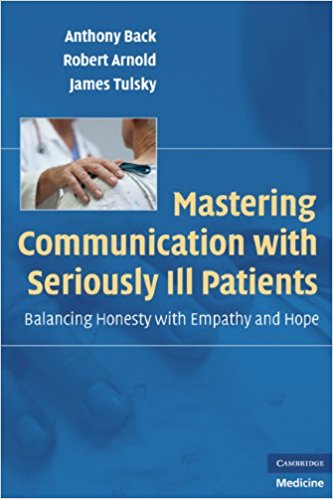 Physicians who care for patients with life-threatening illnesses face daunting communication challenges. Patients and family members can react to difficult news with sadness, distress, anger, or denial. This book defines the specific communication tasks involved in talking with patients with life-threatening illnesses and their families. Topics include delivering bad news, transition to palliative care, discussing goals of advance-care planning and do-not-resuscitate orders, existential and spiritual issues, family conferences, medical futility, and other conflicts at the end of life. Drs. Anthony Back, Robert Arnold, and James Tulsky bring together empirical research as well as their own experience to provide a roadmap through difficult conversations about life-threatening issues. The book offers both a theoretical framework and practical conversational tools that the practicing physician and clinician can use to improve communication skills, increase satisfaction, and protect themselves from burnout.
Physicians who care for patients with life-threatening illnesses face daunting communication challenges. Patients and family members can react to difficult news with sadness, distress, anger, or denial. This book defines the specific communication tasks involved in talking with patients with life-threatening illnesses and their families. Topics include delivering bad news, transition to palliative care, discussing goals of advance-care planning and do-not-resuscitate orders, existential and spiritual issues, family conferences, medical futility, and other conflicts at the end of life. Drs. Anthony Back, Robert Arnold, and James Tulsky bring together empirical research as well as their own experience to provide a roadmap through difficult conversations about life-threatening issues. The book offers both a theoretical framework and practical conversational tools that the practicing physician and clinician can use to improve communication skills, increase satisfaction, and protect themselves from burnout.
Death Foretold: Prophecy and Prognosis in Medical Care
– Nicholas A. Christakis, 2001
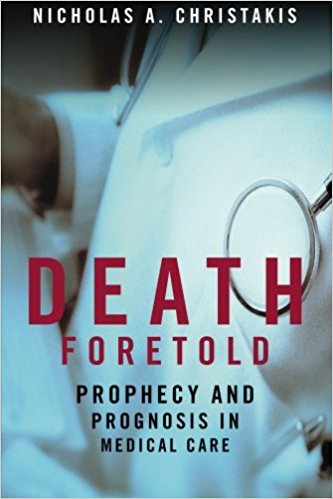 This groundbreaking book explains prognosis from the perspective of doctors, examining why physicians are reluctant to predict the future, how doctors use prognosis, the symbolism it contains, and the emotional difficulties it involves. Drawing on his experiences as a doctor and sociologist, Nicholas Christakis interviewed scores of physicians and searched dozens of medical textbooks and medical school curricula for discussions of prognosis in an attempt to get to the core of this nebulous medical issue that, despite its importance, is only partially understood and rarely discussed.
This groundbreaking book explains prognosis from the perspective of doctors, examining why physicians are reluctant to predict the future, how doctors use prognosis, the symbolism it contains, and the emotional difficulties it involves. Drawing on his experiences as a doctor and sociologist, Nicholas Christakis interviewed scores of physicians and searched dozens of medical textbooks and medical school curricula for discussions of prognosis in an attempt to get to the core of this nebulous medical issue that, despite its importance, is only partially understood and rarely discussed.
“Highly recommended for everyone from patients wrestling with their personal prognosis to any medical practitioner touched by this bioethical dilemma.”—Library Journal, starred review
“[T]he first full general discussion of prognosis ever written. . . . [A] manifesto for a form of prognosis that’s equal parts prediction-an assessment of likely outcomes based on statistical averages-and prophecy, an intuition of what lies ahead.”—Jeff Sharlet, Chicago Reader
“[S]ophisticated, extraordinarily well supported, and compelling. . . . [Christakis] argues forcefully that the profession must take responsibility for the current widespread avoidance of prognosis and change the present culture. This prophet is one whose advice we would do well to heed.”—James Tulsky, M.D., New England Journal of Medicine
How to Break Bad News: A Guide for Health Care Professionals
–Robert Buckman, Yvonne Kason, 1992
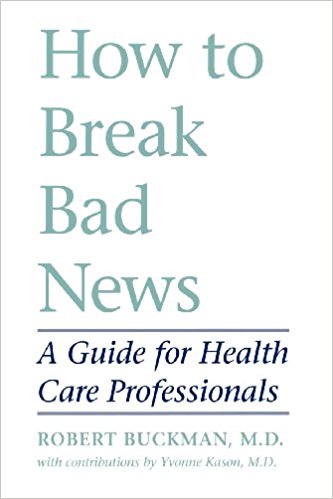 “This short, easy-to-read book… has a great potential to improve the way clinicians understand the process of breaking bad news. The book features clear writing, believable examples, and practical suggestions… Clinicians of every specialty and skill level will benefit from How to Break Bad News. Further, it should be required reading for all medical students and residents who plan to take care of people.” (Annals of Internal Medicine)
“This short, easy-to-read book… has a great potential to improve the way clinicians understand the process of breaking bad news. The book features clear writing, believable examples, and practical suggestions… Clinicians of every specialty and skill level will benefit from How to Break Bad News. Further, it should be required reading for all medical students and residents who plan to take care of people.” (Annals of Internal Medicine)
“In his fine book, Robert Buckman… presents a well-organized, thoughtful, and readily assimilated approach to breaking bad news… At last, we have a wise, useful, readable textbook on the communication of unpleasant information… Buckman has treated an enormously important and complex topic in a sensible, practical, and engaging fashion. Sophisticated concepts are put forth concisely, clearly, and simply, with relatively little jargon… This thoughtful and stimulating presentation will be appreciated by all clinicians faced with the difficult task of sharing bad news.” (New England Journal of Medicine)
“This is an exceptional and important book that excels in its organization, readability, practicality, value, and relevance to family medicine… The book would be helpful (and should be required reading) for health professions students, residents, and junior practitioners of all specialties, but the text is so practical that even seasoned clinicians (perhaps unaware of suboptimal communication styles) would benefit.” (Family Medicine)
“An expert in breaking bad news is not someone who gets it right every time; she or he is merely someone who gets it wrong less often, and who is less flustered when things do not go smoothly.” (from the Introduction)
Practical Plans for Difficult Conversations in Medicine: Strategies That Work in Breaking Bad News
– Robert Buckman, 2010
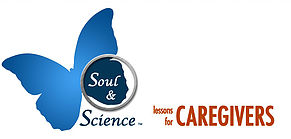
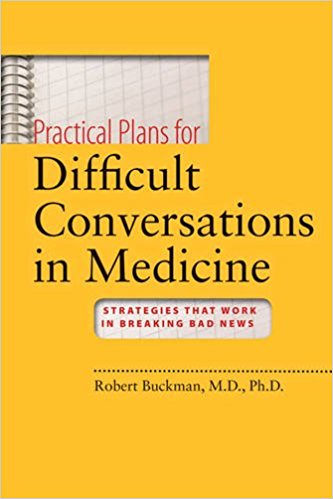 Although they receive extensive clinical training, medical practitioners are given little or no instruction about the best way to break bad news. In this book and DVD set, Robert Buckman, author of How to Break Bad News, offers solid, practical, and practicable guidelines for such conversations as the diagnosis of a serious or fatal illness, the death of a loved one in the hospital, or a disclosure of medical error.
Although they receive extensive clinical training, medical practitioners are given little or no instruction about the best way to break bad news. In this book and DVD set, Robert Buckman, author of How to Break Bad News, offers solid, practical, and practicable guidelines for such conversations as the diagnosis of a serious or fatal illness, the death of a loved one in the hospital, or a disclosure of medical error.